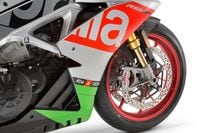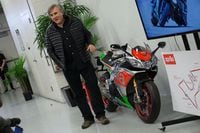You know what I tell people when they ask which superbike is best? I tell them to get the one that they think looks the coolest, sounds the best, or otherwise makes their heart pump. Functionally, high-end sport motorcycles are face-meltingly fast, as stable as family sedans (most of them), and have a dizzying array of features to keep the rider in control. Gone are the days of the horsepower race, or compromising for light handling. A state-of-the-art showroom superbike in 2017 is more capable than 99 percent of us will ever be—which is why it’s the ones that stir our emotions that rise to the top.
It's very common for my conversations about superbikes to lead to Aprilia's RSV4, no matter who the person. The reputation, looks, and sounds of the RSV4 is why people remember it—whether it's their favorite bike or not, they know the bike. Ever since it stepped on the scene in 2009 the flagship machine from Noale, in the north of Italy, has been a mainstay of style and charisma. A clattering, raucous V-4 engine spread at 65 degrees makes for an exhaust note that's second to none in the industry, and Aprilia has been hell bent on making the RSV4 one of the best-handling machines available from the get go. A couple of World Superbike championships since the bike's inception is proof that it works pretty well.
All of this pinged through my head as I peeled into turn 2 aboard the updated-for-2017 RSV4 at Circuit of the Americas in Austin, Texas. The speedo showed around 105 mph and it felt like no more than 60. I rolled the throttle on in third gear until the bar tachometer across the top of the dash board turned orange, sending a salvo of thunder out the exhaust and bouncing off the empty amphitheater of COTA’s famous s-turns. Then I changed direction, knee puck to knee puck, seven times in the next seven turns, easy as can be.
If I was too greedy with the throttle, the dash would light up and tell me that either traction control or wheelie control saved my hide. I would brake as late as I could into the hairpin on the back side of the circuit and the Pirelli Supercorsa reacted like a cat stretching in the sun and then looking up, wondering when it’s going to be fed. Then I lit the fuse on a claimed 201 horsepower down the 1-kilometer back straight, up to 175 mph before squeezing two 330mm front brake discs with Brembo M50 calipers and holding on to the bike with every ounce of god-fearing strength to keep from being thrown forward.
"Well, Zack," you're thinking, "that's what you get when you ride a $23,000 Italian superbike an Ohlins NIX30 fork and TTX36 shock and forged wheels and no passenger seat." True, but it turns out that's also what you get when you ride the "lower" spec version, as I was doing. That bike (the RR model), has Sachs suspension, cast wheels, and a relatively tame matte-black paint job. At $16,999 the RR isn't wildly inexpensive, but considering the cost of entry into the superbike market it's an eye-opening experience to ride RR model and realize it's the bottom of the heap as far as RSV4s are concerned.
The list of features is hard to even discuss without sounding like you’re talking about a MotoGP machine: You can adjust the swingarm pivot, the steering head angle, and even the position of the engine in the frame, not to mention the obvious stuff like front and rear ride height and fully adjustable preload and damping characteristics in the fork and shock.
Then there’s the electronics. The fourth generation of Aprilia’s APRC suite sees three engine maps (Sport, Track, and Race) which adjust power delivery but also engine-braking characteristics, three modes each of wheelie control and launch control, as well as eight levels of traction control. All of which have more advanced parameters thanks to repositioning the sensors in the bike, according to Aprilia. Add to that a quickshifter (now bidirectional, with auto-blip downshifts) and cruise control. There’s even a pit-lane speed limiter so you can feel more like Aleix Espargaro at your track day. When you’re trail braking the ABS parameters measure everything from lever pressure to lean angle to make sure you stay upright, and in two of the three modes will keep the rear wheel on the ground, too.
The list goes on: A TFT dash displays all of the info and options, and combines with the ECU to provide Bluetooth connectivity for your smartphone. That means ECU and IMU data conveyed to your laptop or mobile device so you can review your laps, and even tune the bike corner by corner. These overarching themes of integrating technology into the RSV4 are combined with a typical quest for ultimate performance. Like the lighter pistons and updated valve springs and connecting rods, or the 300-rpm higher rev ceiling, or eliminating 590 grams from the throttle system by eliminating cables and variable intake stacks. Or the fact that the new RSV4 has a new muffler that meets the stricter requirements of Euro-4 regulations but the engine puts out the same power as last year.
These changes are all under the skin and largely overshadowed by the marquee changes to the RSV4, like the color dash and the new switch cluster, or the RF’s exotic Ohlins suspension. Aprilia Racing’s Team Principal, Romano Albesiano (still in town from the Grand Prix of the Americas at COTA), stopped in on the technical presentation and said, through a thick Italian accent, “the bike looks more or less the same, but the amount of work done is unbelievable.” After a handful of sessions around the Circuit of the Americas I was left impressed, as usual, by what passes for a streetbike these days. The RSV4 is viciously fast, incredibly composed, and yet still just as fashionable and appealing as it has always been.
There were only a couple of problems. One, the joystick that controls all of the dash functions isn’t quite as direct as I wanted it to be. Triumph’s new Street Triple as a very similar system and the feel of the controls is better. Version two of Aprilia’s system will no doubt be a little better. The other issue was the occasional bobble from the traction control system. It is much more precise for 2017—seemingly making smaller adjustments more frequently to keep the bike in line—but now and then would stumble over an algorithm and not feed power when I wanted it. This version of APRC is more advanced, but expert riders will likely find it a little bit more frustrating. Yamaha’s R1 still offers the gold standard in electronics for superbikes, in my opinion.
Between the two RSV4s, if it were my tens of thousands of dollars I would opt for the RR version. The RF is dreamy, no doubt—with its silver accents, forged wheels and Ohlins parts, plus the allure of being the cream of the crop. But having flown around COTA as fast as I dared on both bikes I wouldn’t be able to justify the extra $6,000 for the RF model. The RSV4-RR, at $16,999, delivered essentially everything a superbike can these days, without leaving me wanting stiffer suspension or lighter wheels.
It’s my pragmatism coming out. I would opt for the more mellow of the two, in the hopes of keeping my sanity when I rode it on the street. In either case, the RSV4 remains near the top of my list of motorcycles that I just plain want.











/cloudfront-us-east-1.images.arcpublishing.com/octane/CVRUPIB5Q42QMAZGYOPS4YAYZI.jpg)










/cloudfront-us-east-1.images.arcpublishing.com/octane/B6XD6LS6IVCQPIU6HXDJSM3FHY.jpg)
/cloudfront-us-east-1.images.arcpublishing.com/octane/ICL63FEDDRDTTMINYICCEYGMDA.jpg)
/cloudfront-us-east-1.images.arcpublishing.com/octane/FCGZHQXRBZFLBAPC5SDIQLVF4I.jpg)
/cloudfront-us-east-1.images.arcpublishing.com/octane/WNOB6LDOIFFHJKPSVIWDYUGOPM.jpg)

/cloudfront-us-east-1.images.arcpublishing.com/octane/X33NU3E525ECRHXLNUJN2FTRKI.jpg)
/cloudfront-us-east-1.images.arcpublishing.com/octane/6KKT5NNL2JAVBOXMZYS5ZO76YA.jpg)
/cloudfront-us-east-1.images.arcpublishing.com/octane/J5RKG5O455GMPGQRF2OG6LRT7A.jpg)
/cloudfront-us-east-1.images.arcpublishing.com/octane/GX2CIZKQVRH2TATDM26KFG2DAE.jpg)
/cloudfront-us-east-1.images.arcpublishing.com/octane/ZWIDYSAKQZHD5BHREMQILXJCGM.jpg)
/cloudfront-us-east-1.images.arcpublishing.com/octane/CYUHJZCTSJCH3MRAQEIKXK7SCQ.jpg)
/cloudfront-us-east-1.images.arcpublishing.com/octane/LKOFINY56FCXJCANJ5M7ZDQUBY.jpg)
/cloudfront-us-east-1.images.arcpublishing.com/octane/4NBPDACMWJH63JQYJVK3QRBDZI.jpg)
/cloudfront-us-east-1.images.arcpublishing.com/octane/KKHQHRR3FJGX7H2IPU6RALMWG4.jpg)

/cloudfront-us-east-1.images.arcpublishing.com/octane/5IOFS5JAE5FOXMNA23ZRAVVYUU.jpg)
/cloudfront-us-east-1.images.arcpublishing.com/octane/CGXQ3O2VVJF7PGTYR3QICTLDLM.jpg)

/cloudfront-us-east-1.images.arcpublishing.com/octane/OQVCJOABCFC5NBEF2KIGRCV3XA.jpg)
/cloudfront-us-east-1.images.arcpublishing.com/octane/OPVQ7R4EFNCLRDPSQT4FBZCS2A.jpg)
/cloudfront-us-east-1.images.arcpublishing.com/octane/YBPFZBTAS5FJJBKOWC57QGEFDM.jpg)
/cloudfront-us-east-1.images.arcpublishing.com/octane/W5DVCJVUQVHZTN2DNYLI2UYW5U.jpg)
/cloudfront-us-east-1.images.arcpublishing.com/octane/C3VIRIAYNZCTJAZNRLREDS3JCM.jpg)
/cloudfront-us-east-1.images.arcpublishing.com/octane/XXWKUKITWRAF3HCJAWGJ25V7BA.jpg)